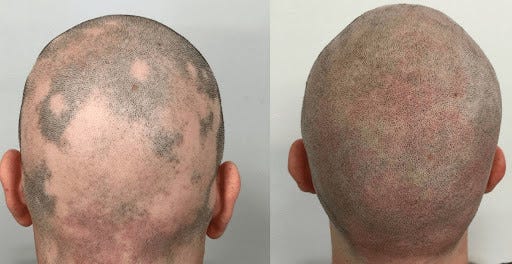SMP Recovery: Quick and Easy

Scalp Micropigmentation (SMP) is a non-invasive treatment that offers a solution for individuals dealing with hair loss. It's praised for its ability to deliver immediate results, and the recovery process is notably quick and easy. Whether you're new to the concept or considering SMP as your next step in your hair restoration journey, understanding the recovery process is crucial. This article will guide you through what to expect after the procedure and how to ensure a smooth and successful recovery.
What is Scalp Micropigmentation?
Before diving into the recovery process, it's essential to have a clear understanding of what Scalp Micropigmentation entails. SMP is a cosmetic procedure that involves the application of tiny, pigmented dots on the scalp to mimic the appearance of hair follicles. It's often described as a "hair tattoo," though it goes far beyond simple tattooing techniques. SMP is designed to create the illusion of a fuller head of hair or to add density to thinning areas. The procedure is ideal for individuals experiencing various forms of hair loss, including male pattern baldness, thinning hair, or alopecia.
Immediate Aftercare: The First 24 Hours
The first 24 hours following your SMP procedure are crucial for setting the foundation for a smooth recovery. After the session, your scalp may appear slightly red and feel tender to the touch, which is a normal reaction. During this time, it's important to avoid touching, washing, or scratching the treated area to prevent infection and ensure the pigment sets properly.
Tips for the First 24 Hours:
- Avoid water exposure: Keep your scalp dry to allow the pigment to settle.
- No physical activity: Refrain from exercising or any activity that may cause sweating.
- Stay out of the sun: UV rays can affect the pigment, so avoid direct sunlight.
Days 2-4: Initial Healing Phase
As you enter the second phase of recovery, you'll notice that the redness will start to subside, and the scalp may begin to feel less tender. This period is when the healing process kicks into gear. The tiny wounds created by the micro-needles during the SMP session will start to close, and your scalp will begin to regenerate.
Tips for Days 2-4:
- Avoid washing your scalp: It's still essential to keep the area dry.
- No scratching: Itching is common as the skin heals, but resist the urge to scratch to avoid disrupting the healing process.
- Continue to avoid physical activity: Stick to low-impact activities that won’t cause excessive sweating.
Day 5-7: Gradual Resumption of Routine
Around day five, you’ll start to notice significant improvements in your scalp's appearance and feel. The tenderness should have diminished, and the redness will likely have faded. By this time, the pigment has begun to settle into the scalp, and you may start to see the final results take shape.
Tips for Days 5-7:
- Gently wash your scalp: You can now start to wash your scalp with lukewarm water and a gentle, sulfate-free shampoo. Avoid scrubbing.
- Moisturize: Applying a light, non-comedogenic moisturizer can help keep your scalp hydrated and promote healing.
- Resume light activities: You can gradually reintroduce low-intensity exercises, but continue to avoid excessive sweating.
Week 2: Final Recovery Phase
By the second week, your scalp should be well on its way to full recovery. The pigment has now fully settled, and any lingering redness or tenderness should be minimal or entirely gone. At this point, you can start to see the true results of your SMP treatment.
Tips for Week 2:
- Return to your normal routine: Most clients can resume their regular activities, including exercising, after the second week.
- Protect your scalp from the sun: Continue to avoid prolonged sun exposure, or use sunscreen and wear a hat when outdoors.
- Avoid harsh hair products: Stick to gentle hair care products to avoid irritating the scalp.
Long-Term Aftercare: Maintaining Your SMP Results
Even after your scalp has fully healed, ongoing care is important to maintain the best possible results. The pigment used in SMP is semi-permanent and can fade over time, particularly if exposed to excessive sunlight or harsh chemicals.
Long-Term Care Tips:
- Use sunscreen: Protect your scalp from UV rays to prevent fading.
- Stay hydrated: Keeping your scalp moisturized will help maintain the vibrancy of the pigment.
- Schedule touch-ups: Depending on your skin type and lifestyle, you may need touch-ups every 2-5 years to keep your SMP looking fresh.
What to Avoid During Recovery
While SMP recovery is generally straightforward, there are certain things you should avoid to ensure optimal healing and results:
- Excessive sun exposure: UV rays can cause the pigment to fade prematurely.
- Swimming: Chlorinated water in pools can affect the pigment, so avoid swimming for at least a month.
- Saunas and steam rooms: High heat and humidity can interfere with the healing process, so it's best to avoid these for at least two weeks.
- Hair dyes and harsh chemicals: Refrain from using any hair dyes or chemical treatments on your scalp until it's fully healed.
Conclusion: Enjoying the Benefits of SMP
Scalp Micropigmentation is a fantastic option for those looking to restore the appearance of a fuller head of hair. The recovery process is quick and easy, making it an attractive choice for individuals with busy lifestyles. By following the proper aftercare guidelines, you can ensure a smooth recovery and enjoy long-lasting, natural-looking results. Whether you're dealing with hair loss or simply want to enhance your look, SMP offers a confidence-boosting solution with minimal downtime.